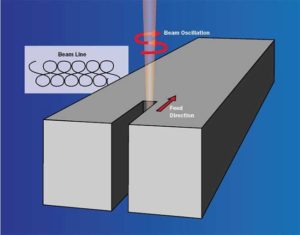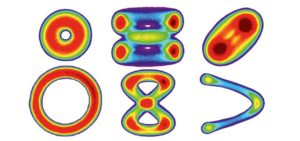The market always dictates evolution and technological innovation. Flexibility, quality and productivity, in a highly reliable process, have led to the development of the Dynamic Beam Shaping.
If until some decades ago laser lived almost only in the science fiction world, today it is used successfully in a broad range of applications, where the energy source is a laser that focuses optical energy on the surface to be processed. The high-density energy melts and vaporizes small portions of the surface where it engraves, in controlled manner, to achieve the wished result. In industrial field, laser finds broad use in cutting operations, on materials that can be metallic, non-metallic and also composites, in the latter case just in virtue of the abrasive nature of the material and of the particular (favourable) conditions that are developed during the laser processing.
Laser cutting in short
 Today the laser cutting is an important process in the sheet metal cutting, to the extent that it has widely surpassed the use of conventional technologies. It is a processing with concentrated energy beams and it is considered a process that occurs by thermal separation, due to the heating, up to the fast melting, of the surface hit by the laser beam that, once penetrated into the material, carries out the cutting through the handling of the beam, of the sheet metal or of both, according to the wished cutting geometry. The melted and vaporized material is removed from the cutting surface by the gas flow, which exits coaxially to the laser beam and, actually, directly influences the cutting cleanliness and quality. The gases used vary according to the materials to be cut. Some physical parameters hold notable importance, like the reflecting power, the thermal conductivity of the sheet metal surface to be cut, its specific and latent heat, of both melting and evaporation: the lower are these properties the more efficient will be the process. It is worth noticing that the cut depth increases with the input power and when the cutting speed and the beam diameter in the work point diminish, with an evident repercussion on the process productivity. This connection influences also efficiency and economy, what is more parameters also influenced by the fact that the surface of the cut profile is generally rough and thermally altered; consequently, successive treatments might become necessary, especially when use conditions are heavy and/or critical. In comparison with conventional sheet metal cutting technologies, the laser one features undisputed advantages connected with the speed, the precision and the quality of the processing, as well as with the relatively low cost.
Today the laser cutting is an important process in the sheet metal cutting, to the extent that it has widely surpassed the use of conventional technologies. It is a processing with concentrated energy beams and it is considered a process that occurs by thermal separation, due to the heating, up to the fast melting, of the surface hit by the laser beam that, once penetrated into the material, carries out the cutting through the handling of the beam, of the sheet metal or of both, according to the wished cutting geometry. The melted and vaporized material is removed from the cutting surface by the gas flow, which exits coaxially to the laser beam and, actually, directly influences the cutting cleanliness and quality. The gases used vary according to the materials to be cut. Some physical parameters hold notable importance, like the reflecting power, the thermal conductivity of the sheet metal surface to be cut, its specific and latent heat, of both melting and evaporation: the lower are these properties the more efficient will be the process. It is worth noticing that the cut depth increases with the input power and when the cutting speed and the beam diameter in the work point diminish, with an evident repercussion on the process productivity. This connection influences also efficiency and economy, what is more parameters also influenced by the fact that the surface of the cut profile is generally rough and thermally altered; consequently, successive treatments might become necessary, especially when use conditions are heavy and/or critical. In comparison with conventional sheet metal cutting technologies, the laser one features undisputed advantages connected with the speed, the precision and the quality of the processing, as well as with the relatively low cost.
Thin sheet metals or thick plates?
The current market indicates a rise of the industrial interest in plates with thickness exceeding 4mm, even if the main share still concerns thin sheet metals. Moreover, as it has happened in all sectors for various years now, flexibility, in terms of both sizes and materials, is nowadays a “diktat”, the reason why studies, also in the field of the sheet metal laser cutting, are evaluating solutions able to assure flexibility, efficiency and quality, in compliance with process economies. Concerning the sheet metal laser cutting, CO2 technology is the most common but new solutions are catching on, like solid-state laser cutting, able to assure interesting performances and higher energy efficiency, as demanded by European provisions. However, the interesting advantages offered tend to decay when the thickness increases, in particular the cutting speed and quality are scarcely satisfactory. The market anyway urges towards flexibility, in other words a fast cutting of thin sheets or a deep penetration, everything in a single system, without adjustments of the kerf sizes according to the application.
From the static beam shaping…
Currently, if we must cut thick plates with the solid-state laser technology, we must turn to “adjustments”, application by application. Maybe the most common method is renowned as Static Beam Shaping that, acting on the various optical elements, allows varying the optical setup, acting on the beam size at the spot, on the beam geometry and other parameters. Naturally, this method absolutely meets the requirements of mass-production where, once executed the setup, it is no longer necessary to intervene but it is not functional if you deal with frequent changeovers, as today it seems to be the daily practice for all industrial realities. To obtain high-quality cutting of thick plates, executed with solid-state laser, it is necessary to turn to post-treatments that remove defects on the cut surface, therefore with an additional cost and an extension of process times, too. Turning to a rise of the cutting power, even if it improves quality and enlarges the process range, is affected by some limits essentially connected with the physical process itself and the resistance of optical components, besides requiring huger investments and management expenses.
… to the Dynamic Beam Shaping

Known with the acronym DBS, the Dynamic Beam Shaping, represents an interesting solution for the laser cutting of thick plates, matching productivity, quality and efficiency. It is not a new process type but an add-on to the laser process. The development of beam shaping systems stems from the analysis of the differences existing between the cutting of low and high thicknesses: in the first case, the fluid-dynamics of the casting is negligible and a higher power density leads to a higher productivity whereas in the second case the fluid-dynamics of the casting is no longer negligible and the possibility of having larger kerfs results in an increment of quality and productivity.
DBS presupposes that the cutting is dynamic, introducing variations in the laser beam geometry as needed; the variation must be easily adjustable, in order to suit different cuts: DBS allows varying the thickness of the sheet metals to be cut without making use of mechanical fittings and without requiring the operator’s intervention because parameters are stored in a database and made usable by a smart control. Moreover, DBS laser cutting needs a universal optical setup. Therefore, through the DBS, it is possible to eliminate the warehouse with more optical elements and the possibility of errors caused by the adjustment decreases, with a general optimization of the process and, in addition, the increase of the feed speed and of the cutting quality. Therefore, DBS results in more reliable and more productive processes featuring improved quality; in general, they are also more efficient,

thanks to the type of interaction generated between laser beam and surface to be cut, too.
Moreover, it is worth pointing out that post-treatments are null or anyway minimized, also in the case of high plates and/or particular steel types, as the cutting edge is clean, without defects like burrs or lumps, and it is non-oxidized. Considering the growing demand for quality and the strong competitiveness of the market, this results in a shrinkage of delivery terms, as well as of the general process costs.
Since the major criticalities in the laser cutting occur with high thicknesses, the Dynamic Beam Shaping allows improving quality, reaching a higher cutting stability and increasing productivity.
DBS: highlights
The use of DBS laser sources provides various advantages, like:
- Rise of productivity –The process speed is really high and, besides this, the cutting quality is such as not to need further interventions
- Low equipment costs – The DBS head is one and the beam is configurable; particular optics are not required
- User-friendliness
- The laser beam can change shape on fly
- Interesting quality, stability of cutting and productivity in case of high thicknesses, too
- Process reliability



